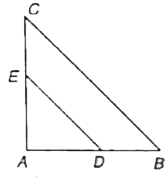. In right angled triangle ABC,∠A is right angle. AD is perpendicular to the hypotenuse BC. Prove that ΔABCΔACD=BC2AC2
Step by step video & image solution for . In right angled triangle ABC,/_A is right angle. AD is perpendicular to the hypotenuse BC. Prove that (DeltaABC)/(DeltaACD)=(BC^2)/(AC^2) by Maths experts to help you in doubts & scoring excellent marks in Class 12 exams.
Updated on:21/07/2023Similar Questions
Knowledge Check
ABC is a right angle triangle at A and AD is perpendicular to the hypotenuse. Then BDCD is equal to :
A(ABAC)2B(ABAD)2CABACDABADABC is a right angle triangle at A and AD is perpendicular to the hypotenuse. Then BDCD is equal to :
A(ABAC)2B(ABAD)2CABACDABADABC is a triangle right angled at Aand a perpendicular AD is drawn on the hypotenuse BC. What is BC.AD equal to ?
AAB .ACBAB . ADCCA .CDDAD . DB
In a right triangle ABC, right angled at A, AD is drawn perpendicular to BC. Prove that:
AB2−BD2=AC2−CD2
View SolutionABC is right angle triangle where AD is perpendicular on hypotenuse BC. If AC = 2 AB find BD.
View SolutionABC is a right-angled triangled, right angled at A⋅AD is drawn perpendicular to BC from A. Then AB2 is equal to
View SolutionABC is triangle right angled at A and a perpendicular AD is drawn on the hypotenuse BC. What is BC⋅AD equal to ?
View SolutionIn a right angle triangle ABC, ∠A is right angle DE is parallel to the hypotenuse BC and the length of DE is 65% the length of BC, what is the area of ΔADE, if the area of ΔABC is 68cm2?

View Solution
